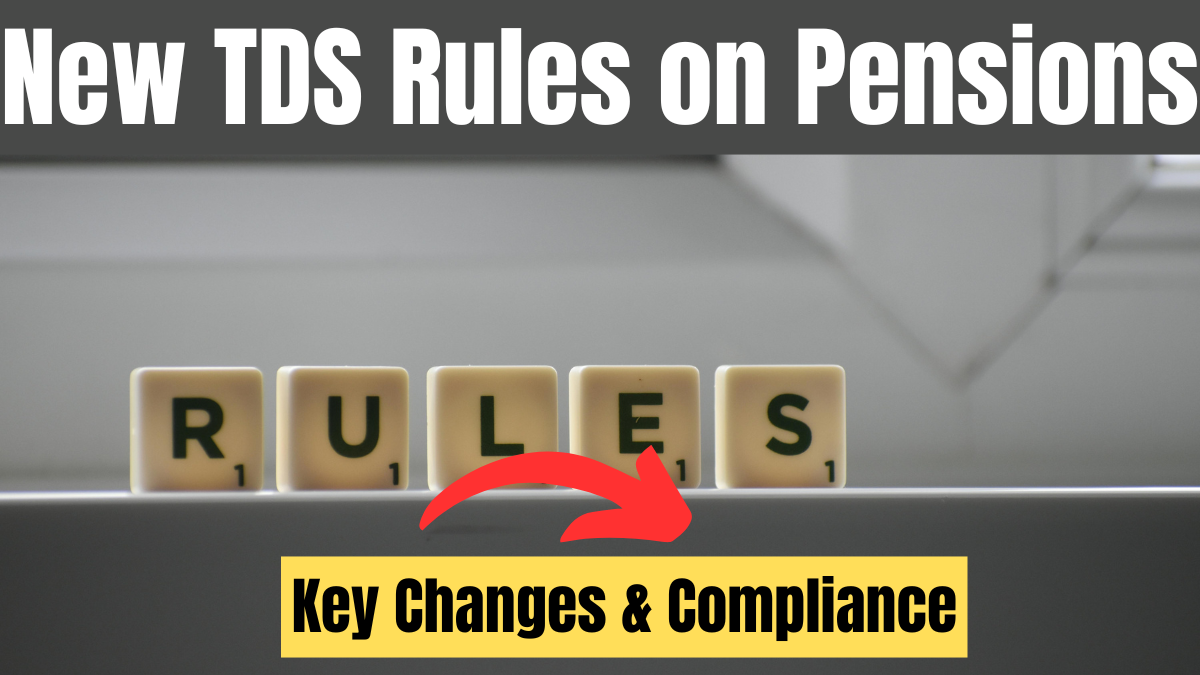The Income Tax Act of 1961 classifies pension income under “Salaries,” meaning it is subject to regular income tax slab rates applicable to salaried employees. Traditionally, TDS (Tax Deducted at Source) was deducted by banks or former employers, and pensioners had to file their Income Tax Returns (ITR) to report their earnings.
With the recent amendments, pensioners must now adhere to stricter compliance measures, particularly those opting for the new tax regime or receiving family pensions. These changes ensure greater transparency and simplified taxation for retirees.

What Has Changed in the TDS on Pension Rules?
The latest TDS rules for pensions bring two major updates:
- Family Pension Now Considered Taxable Income:
Previously, family pension was classified as “Income from Other Sources”, and banks deducted TDS separately. Under the new rule, family pensions must now be included in the total taxable income of the recipient. - Requirement to Submit Form 10-IE for the New Tax Regime:
Pensioners choosing the new tax regime must submit Form 10-IE to their tax deductor to ensure accurate TDS deductions and proper tax compliance.
One crucial provision remains unchanged—pensioners can still claim a ₹50,000 standard deduction on their pension income. However, those receiving both a pension and salary from post-retirement employment can claim the deduction only once.
Higher Tax Deduction Under Section 206AB
A significant change involves pensioners who fail to file ITR for two consecutive years. If their total TDS deduction exceeds ₹50,000 in any of these years, they will be subject to a higher TDS rate under Section 206AB.
This provision aims to encourage timely tax filing and prevent revenue loss due to non-compliance. Pensioners must ensure their ITRs are filed regularly to avoid paying a higher tax rate.
Declaring Additional Income Sources
Pensioners earning income from additional sources such as:
- Fixed Deposits (FD) interest
- Rental income
- Capital gains from investments
must ensure these earnings are accurately declared in their ITR. Failure to report such income can lead to:
- Mismatches in tax records
- Additional tax liabilities
- Possible penalties from the Income Tax Department
Maintaining proper documentation and disclosing all sources of income will prevent discrepancies and financial complications.
Steps for Compliance
To comply with the revised TDS regulations, pensioners should follow these steps:
- File ITR on Time: Ensure ITR filing before the deadline to avoid penalties and higher TDS rates.
- Monitor TDS Deductions: Regularly check Form 26AS and the Annual Information Statement (AIS) on the Income Tax Portal.
- Choose Tax Regime Wisely: Opt for either the old or new tax regime and submit Form 10-IE if required.
- Declare All Income Sources: Report income from family pensions, fixed deposits, and other sources to avoid tax mismatches.
- Consult a Tax Expert: Seeking professional advice can help optimize deductions and ensure compliance with the latest tax laws.
The Significance of These Changes
The revised TDS rules aim to:
- Improve tax compliance among pensioners
- Prevent tax evasion
- Ensure accurate tax deductions at source
For pensioners, staying informed and following the updated tax guidelines is crucial to avoid penalties and ensure financial stability.
Frequently Asked Questions
What is the key change in TDS on pensions for 2025?
The biggest change is the inclusion of family pensions in the total taxable income, rather than treating them as “Income from Other Sources.” This means pensioners must declare family pensions while filing ITR.
Who needs to submit Form 10-IE?
Pensioners choosing the new tax regime are required to submit Form 10-IE to ensure correct TDS deductions.
What happens if I do not file my ITR for two consecutive years?
If you fail to file ITR for two consecutive years and your total TDS exceeds ₹50,000, you will be subject to a higher TDS rate under Section 206AB.
Can I claim a standard deduction of ₹50,000 on my pension?
Yes, all pensioners can claim a ₹50,000 standard deduction. However, if you are receiving both a pension and a salary, the deduction can be claimed only once.
How do I check my TDS deductions?
You can check your TDS deductions by reviewing Form 26AS and the Annual Information Statement (AIS) on the Income Tax Portal.
What happens if I forget to declare additional income like FD interest?
Failing to declare additional income may result in tax mismatches and additional liabilities. It is important to report all earnings to avoid penalties.
Are pensioners required to pay tax if their total income is below ₹2.5 lakh?
No, pensioners whose total annual income is below ₹2.5 lakh are not required to pay tax. However, they must still file their ITR to maintain a clean tax record.
How can I ensure I am compliant with the latest TDS rules?
To stay compliant, follow these steps:
- File your ITR on time
- Check Form 26AS regularly
- Submit Form 10-IE if opting for the new tax regime
- Declare all sources of income
- Consult a tax advisor for expert guidance
Final Thoughts on TDS Changes for Pensioners
The latest TDS modifications highlight the importance of staying informed and compliant with evolving tax laws. By understanding these updates, pensioners can:
- Avoid unnecessary tax deductions
- Ensure financial stability
- Optimize tax benefits
For a hassle-free tax filing process, pensioners should proactively track their tax obligations and seek expert financial advice when needed. Staying compliant with these updates will not only prevent financial issues but also secure a smooth taxation experience.
Aanchal is a passionate writer with a keen interest in storytelling, content creation, and creative expression. She enjoys exploring diverse topics and crafting engaging narratives that captivate readers.